Aurora, Illinois, Hgh State Clinic, Hgh Injections, Hrt Doctors
Aurora, Illinois Blood Testing Facilities
 Represents a LabCorp blood testing facility
Represents a LabCorp blood testing facility Represents a Quest Diagnostics blood testing facility
Represents a Quest Diagnostics blood testing facility

Nearby Labcorp Blood Testing facilities:
- Labcorp Center Distance: 7 m, 2272 W 95Th Street Ste 100, Naperville, Will County, IL, 60564
- Labcorp Center Distance: 9 m, 1020 E Ogden Ave Ste 208, Naperville, Dupage County, IL, 60563
- Labcorp Center Distance: 18 m, 330 North Madison Ste B2, Joliet, Will County, IL, 60435
- Labcorp Center Distance: 19 m, 522 W Chestnut Street, Hinsdale, Dupage County, IL, 60521
- Labcorp Center Distance: 20 m, 450 Dundee Ave, Elgin, Kane County, IL, 60120
- Labcorp Center Distance: 22 m, 2025 S. Chicago Street, Joliet, Will County, IL, 60436
- Labcorp Center Distance: 25 m, 10737 W. 165Th Street, Orland Park, Cook County, IL, 60467
- Labcorp Center Distance: 27 m, 121 South Wilke Rd 405, Arlington Heights, Cook County, IL, 60005
- Labcorp Center Distance: 29 m, 16325 Harlem Ave Ste 110, Tinley Park, Cook County, IL, 60477
- Labcorp Center Distance: 30 m, 6191 N Canfield Ave, Chicago, Cook County, IL, 60631
- Labcorp Center Distance: 32 m, 5911 Northwest Highway Ste 108, Crystal Lake, McHenry County, IL, 60014
- Labcorp Center Distance: 34 m, 2601 Compass Rd Suite 135, Glenview Nas, Cook County, IL, 60026
- Labcorp Center Distance: 36 m, 111 N. Wabash Avenue Ste 1710, Chicago, Cook County, IL, 60602
- Labcorp Center Distance: 46 m, 35 Tower Ct Ste E, Gurnee, Lake County, IL, 60031
- Labcorp Center Distance: 54 m, 387 East 84Th Dr, Merrillville, Lake County, IN, 46410
- Labcorp Center Distance: 60 m, 9150 E 109Th Ave Ste C-1, Crown Point, Lake County, IN, 46307
- Labcorp Center Distance: 61 m, 6530 Sheridan Road, Kenosha, Kenosha County, WI, 53143
- Labcorp Center Distance: 69 m, 880 Eastport Centre 2Nd Floor, Valparaiso, Porter County, IN, 46383
- Labcorp Center Distance: 84 m, 4931 S 27Th St, Milwaukee, Milwaukee County, WI, 53221
- Labcorp Center Distance: 86 m, 12555 W National Ave, New Berlin, Waukesha County, WI, 53151
- Labcorp Center Distance: 87 m, 5631 W Lincoln Ave, West Allis, Milwaukee County, WI, 53219
- Labcorp Center Distance: 89 m, 1502 S. Layton Blvd, Milwaukee, Milwaukee County, WI, 53215
- Labcorp Center Distance: 90 m, 756 N 35Th St, Milwaukee, Milwaukee County, WI, 53223
- Labcorp Center Distance: 91 m, 2645 N Mayfair Rd Suite 110, Milwaukee, Milwaukee County, WI, 53226
- Labcorp Center Distance: 92 m, 3040 N 117Th St 210, Wauwatosa, Milwaukee County, WI, 53226
- Labcorp Center Distance: 93 m, 8500 W Capitol Suite 201B, Milwaukee, Milwaukee County, WI, 53222
- Labcorp Center Distance: 95 m, 2419 W. Cornerstone Ct Ste B, Peoria, Peoria County, IL, 61614
Nearby Quest Blood Testing facilities:
- Quest Center Distance: 2 m, 2088 Ogden Ave, Aurora, Kane County, IL, 60504-4376
- Quest Center Distance: 6 m, 1180 W Wilson St, Batavia, Kane County, IL, 60510-7693
- Quest Center Distance: 8 m, 24600 W 127Th St, Plainfield, Will County, IL, 60585-9507
- Quest Center Distance: 9 m, 2631 Williamsburg Ave, Geneva, Kane County, IL, 60134-1111
- Quest Center Distance: 10 m, 1100 W Veterans Pkwy, Yorkville, Kendall County, IL, 60560-4728
- Quest Center Distance: 12 m, 484 W Boughton Rd, Bolingbrook, Will County, IL, 60440-2398
- Quest Center Distance: 14 m, 7530 Woodward Ave, Woodridge, Dupage County, IL, 60517-3100
- Quest Center Distance: 16 m, 1113 Fairview Ave, Westmont, Dupage County, IL, 60559-2709
- Quest Center Distance: 17 m, 885 S Randall Rd, Elgin, Kane County, IL, 60123-3002
- Quest Center Distance: 18 m, 310 N Hammes Ave, Joliet, Will County, IL, 60435-5676
- Quest Center Distance: 19 m, 534 Chestnut St, Hinsdale, Dupage County, IL, 60521-3175
- Quest Center Distance: 22 m, 2500 W Higgins Rd, Hoffman Estates, Cook County, IL, 60169-7208
- Quest Center Distance: 23 m, 808 E Woodfield Rd, Schaumburg, Cook County, IL, 60173-4714
- Quest Center Distance: 25 m, 3244 Sycamore Rd, Dekalb, Dekalb County, IL, 60115-4941
- Quest Center Distance: 26 m, 9046 W 159Th St, Orland Park, Cook County, IL, 60462-5646
- Quest Center Distance: 27 m, 19070 Everett Blvd, Mokena, Will County, IL, 60448-2073
- Quest Center Distance: 28 m, 337 W Northwest Hwy, Palatine, Cook County, IL, 60067-2414
- Quest Center Distance: 29 m, 10837 S Cicero Ave, Oak Lawn, Cook County, IL, 60453-6458
- Quest Center Distance: 30 m, 22285 Pepper Rd, Barrington, Lake County, IL, 60010-2538
- Quest Center Distance: 31 m, 1600 Dempster St, Park Ridge, Cook County, IL, 60068-1172
- Quest Center Distance: 32 m, 260 E Congress Pkwy, Crystal Lake, McHenry County, IL, 60014-6235
- Quest Center Distance: 33 m, 4801 W Peterson Ave, Chicago, Cook County, IL, 60646-5725
- Quest Center Distance: 34 m, 2551 Compass Rd, Glenview, Cook County, IL, 60026-8042
- Quest Center Distance: 35 m, 1450 Busch Pkwy, Buffalo Grove, Lake County, IL, 60089-4541
- Quest Center Distance: 36 m, 2800 N Sheridan Rd, Chicago, Cook County, IL, 60657-6118
- Quest Center Distance: 37 m, 800 Austin St, Evanston, Cook County, IL, 60202-3439
- Quest Center Distance: 38 m, 565 Lakeview Pkwy, Vernon Hills, Lake County, IL, 60061-1839
- Quest Center Distance: 40 m, 17665 Torrence Ave, Lansing, Cook County, IL, 60438-4839
- Quest Center Distance: 43 m, 8840 Calumet Ave, Munster, Lake County, IN, 46321-2546
- Quest Center Distance: 46 m, 15 Tower Ct, Gurnee, Lake County, IL, 60031-5708
- Quest Center Distance: 47 m, 1854 E Grand Ave, Lindenhurst, Lake County, IL, 60046-7821
- Quest Center Distance: 49 m, 641 Highgrove Pl, Rockford, Winnebago County, IL, 61108-2506
- Quest Center Distance: 52 m, 5901 E Riverside Blvd, Rockford, Winnebago County, IL, 61114-4935
- Quest Center Distance: 54 m, 119 E 93Rd Ave, Crown Point, Lake County, IN, 46307-8601
- Quest Center Distance: 59 m, 10117 74Th St, Kenosha, Kenosha County, WI, 53142-7533
- Quest Center Distance: 66 m, 813 N. Porter Campus Dr, Valparaiso, Porter County, IN, 46383-8947
- Quest Center Distance: 85 m, 4852 S 6Th St, Milwaukee, Milwaukee County, WI, 53221-2462
- Quest Center Distance: 91 m, 2600 N Mayfair Rd, Wauwatosa, Milwaukee County, WI, 53226-1309
- Quest Center Distance: 93 m, 503 N Prospect Rd, Bloomington, McLean County, IL, 61704-7723
- Quest Center Distance: 96 m, 2500 Niles Rd, Saint Joseph, Berrien County, MI, 49085-3272
Hormone Replacement Therapy Services for the State of Illinois
Are you over the age of thirty and feel that symptoms related to premature aging are bringing you down? You may actually be suffering from a condition known as hormone imbalance. Two of the most common forms of Hormone Imbalance which are associated with the aging process are Testosterone Deficiency and Human Growth Hormone Deficiency.
The Conscious Evolution Institute provides Pharmaceutical Hormone Replacement Therapy Solutions for men and women all across the United States.
HGH Deficiency Treatments in Chicago and Greater Illinois
Do you find yourself dragging as you grow older? Are you experiencing weight gain and loss of muscle mass even though you haven't changed your lifestyle? Are you experiencing psychological issues, not associated with your life circumstances, such as depression or a loss of well-being?
You may be suffering from Human Growth Hormone Deficiency, also known as Somatopause. Human beings are sensitive to hormonal changes, and as we get older, our brains secrete less and less of this vital hormone. With regular Bio-Identical HGH Shots, it is possible to negate the effects of Somatopause, potentially improving your physiological health, improving your outlook as well as reducing your mortality risk.
Sermorelin Acetate HGH Deficiency Treatment
HGH Injections aren't the only way to restore Growth Hormone Levels, however. The Conscious Evolution Institute also offers Recombinant Sermorelin Therapy, which boosts natural HGH Production by safely stimulating the pituitary gland. We can help you decide which form of treatment is best for you.
Low-T Treatments in Chicago and Greater Illinois
Testosterone Deficiency is also a major medical disorder which has the capacity to significantly disrupt the lives of both men and women. Like HGH, Testosterone production starts to fade around the time that we reach our mid-twenties. Many men don't experience issues for years or decades, but other men are much more sensitive to these hormonal changes.
Low-T is also referred to as Andropause, because it has a tendency to become symptomatic around the same period as Menopause, and can have the same powerful impact on health and wellness. If you are experiencing severe fatigue, loss of muscle mass, anxiety, or weight gain in combination with a lack of libido or loss of sexual ability, there is a major chance that you are suffering from Low-T and can benefit from the various Bio-Identical Low-T solutions that we provide.
HCG Weight Management Treatments in Chicago and Greater Illinois
Not all hormone treatments are intended specifically to correct hormone imbalance. HCG Injections are a form of Bio-Identical Hormone Replacement Therapy which has been proven as an effective medical treatment for obesity.
For men and women that have spent years struggling with their weight, HCG has the ability to break the cycle of dieting and binging which causes so many diets to fail. HCG, when combined with low calorie diet, leads to rapid weight loss, while significantly reducing the feelings of hunger and loss of energy associated with such a diet. HCG helps break free energy trapped in your adipose fat tissue, helping you maintain a healthy metabolism even with a significant reduction in caloric consumption.
Largest Cities in Illinois
Chicago
Chicago, is the largest city in Illinois, and is one of the largest cities in the United States. The only cities in America larger than Chicago are Los Angeles and New York City. Chicago is frequently referred to by its nickname: The Windy City. It's location adjacent to Lake Michigan causes it to experience high levels of snow and wind.
Chicago is also referred to as the Second City, because of its significant size and cultural importance, historically only considered second to New York City. Because Chicago is such a large city, it has a number of sports teams. Chicago is home to the MLB teams the Chicago Cubs and White Sox. It is also home to the NFL Chicago Bears and the NBA Chicago Bulls.
Aurora
Aurora is the second largest city in Illinois, as well as the largest suburb of Chicago. Historically, Aurora was known as The City of Lights, because it was among the first places in America to have street lights controlled completely by electricity.
A unique thing about Aurora is that it has a high concentration of buildings with renowned architecture, with buildings designed by architectural mavens such as Bruce Goff and Frank Lloyd Wright. Like many cities in the Midwest, Aurora has long been known for its significant contribution to national manufacturing.
Rockford
Rockford, Illinois is the third largest city in the state of Illinois, and the largest city outside of the Metro Chicago area. Rockford is often mentioned by the nickname, The Forest City, because of the many large elm trees located throughout the city. It was also one of the first cities in the United States with organized baseball, hosting a team called the Rockford Forest City.
Rockford has experienced issues in recent years because of the decline of the manufacturing sector in the Midwest, but has entered a new era of revitalization in recent years. Today, the largest private sector business in the city is Belvedere Assembly Plant for Chrysler and the largest Public Sector employer is the Rockford school system.
Joliet
Joliet, Illinois is the fourth largest city in Illinois, and is the second largest suburb of Chicago. Joliet is located southwest of Chicago, and is growing faster than any other city in the state. Joliet is often referred to as The City of Champions because of the massive success of the bands of the Joliet Township public school system.
Joliet, like many other cities in the Rust Belt, experienced a significant loss of jobs as manufacturing declined in the area, but its proximity to Chicago has caused it to bounce back in a big way as a suburb for men and women that commute to Chicago. Joliet also has an active entertainment district in its city center, with the minor league team the Joliet Slammers and Harrah's Joliet Casino.
Naperville
Naperville, Illinois is the 5th largest city in the state of Illinois, as well as the third largest suburb of Chicago. Naperville also has the unique distinction of being considered the richest city in the Midwest as well as one of the best cities to live in and raise a family in America.
Naperville belongs to an area known as the Illinois Tech and Research Corridor, and has a large number of high tech jobs, the most significant of which being Alcatel-Lucent and Nicor. Although high tech is the largest industry in the city, the largest single employer is Edward Hospital.
All About Aurora, Illinois Geographic Area
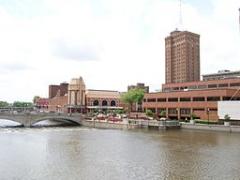
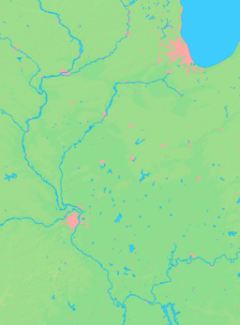
Aurora is the second most populous city in the U.S. state of Illinois, and the 112th largest city in the United States. The population in 2010 was 197,899.
Once a mid-sized manufacturing city, Aurora has grown tremendously due to urban sprawl over the past 50 years. Originally founded within Kane County, Aurora's city limits and population now spill over into DuPage, Will and Kendall Counties. Between 2000 and 2003, the U.S. Census Bureau ranked Aurora as the 34th fastest growing city in the United States. From 2000 to 2009, the U.S. Census Bureau ranked the city as the 46th fastest growing city with a population of over 100,000.
In 1908, Aurora officially adopted the nickname "City of Lights", because it was one of the first cities in the United States to implement an all-electric street lighting system in 1881. Aurora's downtown is located on the Fox River. The historic downtown is centered on Stolp Island. The city is divided into three regions, The West Side, located on the west side of the Fox River, The East Side, located between the eastern bank of the fox river and the Kane/DuPage County line, and the Far East Side/Fox Valley, which is from the County Line to the city's eastern border with Naperville.
The Aurora area is home to one of the most impressive architectural collections in the Midwest, featuring structures by Frank Lloyd Wright, Ludwig Mies van der Rohe, Bruce Goff and George Grant Elmslie. The Hollywood Casino, a dockside gaming facility with 53,000 square feet (4,900 m2) and 1,200 gaming positions, is located on the river in downtown Aurora. Aurora is also home to a large collection of Sears Catalog Homes (over 50 homes) and Lustron all-steel homes (seven homes).
Before European settlers arrived, there was a Native American village in what is today downtown Aurora, on the banks of the Fox River. In 1834, following the Black Hawk War, the McCarty brothers arrived and initially owned land on both sides of the river, but sold their lands to the Lake Brothers on the west side. The Lake Brothers opened a mill on the opposite side of the river. The McCartys lived and operated their mill on the east side. A post office was established in 1837, officially creating Aurora. Actually, however, Aurora was originally two villages: East Aurora, incorporated in 1845, on the east side of the river, and West Aurora, formally organized on the west side of the river in 1854. In 1857, the two towns joined officially incorporated as the city of Aurora. The two sides couldn't agree on which side of the river should house the public buildings, so most public buildings were built on or around Stolp Island in the middle of the Fox River.
As the city grew, many factories and jobs came to Aurora, along with many people. In 1856, the Chicago, Burlington and Quincy Railroad located its roundhouse and locomotive shop in Aurora to become the town's largest employer until the 1960s. Many of the heavy industries were located on the East side which provided employment for many generations of European immigrants. Many immigrants flocked to the city, mainly from Great Britain, Ireland, Scandinavia, Luxembourg, Germany, France, and Italy. Aurora became main economic center of the Fox Valley region. The combination of these three factors aea highly industrialized town, a sizable river that divided it, and the Burlington's shops aeaccounted for much of the dynamics of Aurora's political, economic, and social history. The city was inclusive and tolerant, and welcomed a variety of immigrants and openly supported abolitionism prior to the American Civil War. Mexican migrants began arriving after 1910. Socially, the town was progressive in its attitude toward education, religion, welfare, and women. The first free public school district in Illinois was established in 1851 and a high school for girls came four years later.
The city was a manufacturing powerhouse until the early 1970s, when the railroad shops closed. Soon many other factories and industrial areas relocated or went out of business. By 1980, there were few industrial areas operating in the city, and unemployment soared to 16%. During the late 1970s and early 1980s, development of the Far East side along the Eola Road and Route 59 areas began. While this was financially beneficial to the city, it also contributed to the decline of the downtown and the manufacturing sectors on the near East and West Sides. Crime rates soared and street gangs started to form in the mid 1980s. It was during this time that Aurora became a much more culturally diverse city. The Hispanic population started to grow rapidly in the city in the 1980s. In the late 1980s, several business and industrial parks were established on the outskirts of the city. In 1993, the Hollywood Casino was built downtown, which helped bring the first redevelopment to the downtown area in nearly twenty years. In the late 1990s, more development began in the rural areas and towns outside of Aurora. Subdivisions sprouted up all around the city, and Aurora's population soared.
Today, Aurora is a culturally diverse city of nearly 200,000 residents. Historic areas downtown are being redeveloped, and new developments are being built all over the city.
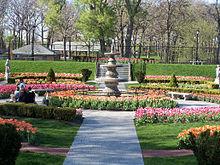
Aurora is located at 41 °45 a²48 a³N 88 °17 a²24 a³W / 41.76333 °N 88.29 °W / 41.76333; -88.29 (41.7634594 -88.2900680).
According to the 2010 census, the city has a total area of 45.80 square miles (118.6 km2), of which 44.94 square miles (116.4 km2) (or 98.12%) is land and 0.86 square miles (2.2 km2) (or 1.88%) is water.
While the city has traditionally been regarded as being in Kane County, Illinois, Aurora is one of only three cities in Illinois whose city limits actually include parts of four counties (the others are Barrington Hills and Centralia, Illinois): Kane, DuPage, Kendall, and Will.
Though politically the city is divided into several wards, Aurora is generally divided into three regions:
The annual precipitation for Aurora is about 40 inches. The record high for Aurora is 111 °F (44 °C), on July 14, 1936. The record low is na26 °F ( na32 °C), on January 20, 1985. The average high temperature for Aurora in July is 84 °F (29 °C), the average January low is 10 °F ( na12 °C).
On July 17 ae18, 1996, a major flood struck Aurora, with 16.9 inches (430 mm) of rain in a 24 hour period, which is an Illinois state record, and the second highest ever nationally. Flooding occurred in almost every low lying area, and in the Fox River valley. The flooding was just as bad in Blackberry Creek, on Aurora's far west side.
Aurora has not been struck by any major tornadoes in recent history, although they occur in Northern Illinois annually. In 1906, a tornado went through the Aurora Driving Park, a large recreation/amusement park and race track located where the Riddle Highlands neighborhood and Northgate shopping center is now located. The tornado hit during the afternoon performance of the Ringling Brothers "Greatest Show on Earth" circus, when the park was crowded. It killed 2 people and injured 22, but the grandstand was still filled for the evening performance. Weak Tornadoes struck the city in 1954, 1958, 1960, and 1991. In 1990, the Supercell Thunderstorm that produced the Deadly Plainfield Tornado passed over the city, dropping golf ball sized hail and causing wind damage. Less than ten minutes after passing through Aurora, the storm produced an F5 tornado in nearby Oswego, which traveled through Plainfield and Joliet and killed 29 people.
The city can receive heavy snowfall and experiences blizzards periodically.
Aurora was hit with one of the strongest earthquakes ever to strike Illinois on May 26, 1909. It put cracks through chimneys and could be felt 500,000 sq mi (1,300,000 km2) around.
As of the census of 2000, there were 142,990 people, 46,489 households, and 34,215 families residing in the city. The average number of residents to one household is 3.6 residents. The population density was 3,711.5 inhabitants per square mile (1,433.0 /km2). There were 48,797 housing units at an average density of 1,266.6 per square mile (489.0 /km2). The racial makeup of the city was 51.07% White, 19.06% African American, 0.36% Native American, 3.06% Asian American, 0.03% Pacific Islander, 14.52% from other races, and 2.0% from two or more races. Hispanic or Latino of any race were 46.56% of the population.
There were 46,489 households, out of which 44.2% had children under the age of 18 living with them, 56.5% were married couples living together, 12.0% had a female householder with no husband present, and 26.4% were non-families. 20.6% of all households were made up of individuals and 5.3% had someone living alone who was 65 years of age or older. The average household size was 3.04 and the average family size was 3.55.
In the city, the population was spread out with 31.7% under the age of 18, 10.2% from 18 to 24, 35.9% from 25 to 44, 15.9% from 45 to 64, and 6.3% who were 65 years of age or older. The median age was 29 years. For every 100 females, there were 101.5 males. For every 100 females age 18 and over, there were 99.3 males.
The median income for a household in the city was $54,861, and the median income for a family was $61,113. Males had a median income of $41,429 versus $30,150 for females. The per capita income for the city was $22,131. About 6.2% of families and 8.5% of the population were below the poverty line, including 10.9% of those under age 18 and 7.3% of those age 65 or over.
Aurora is on the edge of the Illinois Technology and Research Corridor. The city has a long tradition of manufacturing as does much of Chicago metropolitan area. Prominent manufacturers, past and present, included: Lyon Workspace Products, The Aurora Silverplate Manufacturing Company, Barber-Greene Company, the Chicago Corset Company, the Aurora Brewing Company, Stephens-Adamson Company, Caterpillar Inc., Allsteel Metals, National Metalwares, and Western Wheeled Scraper Works (later Austin-Western Inc.). The most prominent employer and industry was the Chicago Burlington and Quincy Railroad (later Burlington Northern) which was headquartered in Aurora. The CB&Q Roundhouse is still standing, and is now the popular restaurant originally called Walter Payton's Roundhouse; after the Payton estate terminated its involvement in 2009 it became known as America's Historic Roundhouse, and (following a 2011 change in ownership) it is now known as Two Brothers Roundhouse.
Formed in 1987, the Aurora Area Convention and Visitors Bureau (AACVB) is a private, nonprofit organization dedicated to aggressively promoting and marketing the area as a premier overnight destination. The goal of the AACVB is to enhance the economic and environmental well-being of a region comprising ten communities: Aurora, Batavia, Big Rock, Hinckley, Montgomery, North Aurora, Plano, Sandwich, Sugar Grove, and Yorkville.
According to the City's 2009 Comprehensive Annual Financial Report, the largest employers in the city are:
Aurora's downtown is full of architectural landmarks and historic places. A non-profit organization, Sri Venkateswara Swami Temple of Greater Chicago, is a major Hindu temple. Aurora also has its own zoo, Phillips Park Zoo, located in Phillips Park (Aurora, IL).
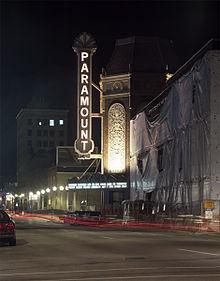
Downtown Aurora is home to the Paramount Theatre, a large live performance theater on the National Register of Historic Places, and the Hollywood Casino. There is also the Leland Tower, a former hotel which was the tallest building in Illinois outside the Chicago city limits and is on the National Register of Historic Places. The largest collection of George Grant Elmslie (Prairie architect - studied under Louis Sullivan) commercial buildings is located here. Also located downtown is the main building of Aurora Public Library and a branch campus of Waubonsee Community College. Downtown Alive, a festival that includes live music and a variety of food booths, is held on three weekends (Friday and Saturday night) in the summer; Blues on the Fox (featuring national blues artists) is held on the Friday and Saturday of Father's Day weekend. Roughly 8,000 ae13,000 people attend. The quarterly AuroraArtWalk is hosted by the Cultural Creatives aea grassroots team of local artist, property owners, patrons and the City of Aurora. The Riverfront Playhouse is a not-for-profit theater that has held a storefront location in downtown Aurora since 1978.
A fixture of Downtown Aurora, the Waubonsee Community College Campus, which formerly sat on Stolp Island near the Paramount Theatre, has recently been closed, as a new and greatly expanded campus was built on the Western banks of the river, between the river and IL Route 31. The construction of the campus was part of a larger plan to re-develop the Downtown area, putting in parks and new walking paths, making the area more inviting. The plan also included a pedestrian bridge, which would connect the two banks of the river. Also in the works is a plan to re-do or reconstruct the bridges onto Stolp Island, which have not been taken care of for close to 60 years.
Aurora has a rich history of entertainment. There were several theaters in the downtown area and several large community parks with baseball stadiums, circus acts, and race tracks. Some of the more popular were:
Aurora was once home to the Aurora Islanders/Blues/Foxes, a minor league baseball franchise that played from 1910-1915 in the Illinois-Wisconsin League. Their most famous player was Casey Stengel, who played one season with the team before being bought by the Brooklyn Dodgers. Stengel batted .352 and was the batting champion of the league for 1911, and also led the league with 50 stolen bases and had 27 outfield assists. The team played in a stadium on the west side in the former Riverview Park.
Waubonsie Valley High School (IPSD - District 204) Soccer won the Northern Illinois regional championship in this highly competitive region, for both boys and girls, almost every year since 1987. In 2007, the Waubonsie Valley High School girl's team won the state championship and went on to achieve the #1 ranking of all high school girl's soccer teams in the United States, finishing with an undefeated season. Aurora has numerous youth soccer clubs, most of which have teams represented in the top five percent of the Northern Illinois Soccer League. Numerous youth soccer players from Aurora have been awarded college scholarships to major college soccer programs throughout the U.S. In addition to this legacy of success in soccer, Aurora maintains several developmental advantages for soccer enthusiasts. Three high quality indoor soccer venues allow for year-round soccer training and competition for children and adults. Additionally, several area traveling soccer clubs, as well as high schools, boast coaches and trainers who have played soccer professionally or have been starting players for national teams from various countries. Some even played for teams that won the World Cup. Supplementing the local soccer training regimen are professional soccer trainers from England, Brazil, The Netherlands, Scotland, and various other countries. Several of these trainers played in the Premier League and for the Brazil national team, and for the Argentina national team.
Fastpitch softball has been in Aurora since the 1930s and gained popularity after World War II when the Aurora Sealmasters Men's team finished fifth in the nation in 1950. The Sealmasters went on to win National Championships in 1959, 1961, 1965 and 1967 and World Championships in 1966 and 1968. The Sealmasters played their games at Stevens-Adamson Field, which was a significant fastpitch stadium on Ridgeway Avenue on the cities southwest side. The Sealmasters hosted many famous competitors from all over the United States, most notably Eddie Feigner and The King and His Court, as well as International opponents. There were many different and competitive men's leagues in Aurora from the 1960s through the mid-1990s. There are still a few leagues and teams playing to this day.
In golf, the Stonebridge Country Club, on Aurora's far northeast side, was home to the LPGA Tour's Kellogg-Keebler Classic from 2002-2004. Stonebridge was also hosted the Ameritech Senior Open from 1991-1995 on the Senior PGA Tour.
Aurora University has Men's and Women's Basketball, Golf, Tennis, Track and Field and Cross Country. It also has a men's football and baseball team, as well as women's softball and volleyball teams. Aurora University athletics are division III.
High school athletics are a major event in the city, as East and West Aurora High Schools have been rivals in all sports for over 100 years.
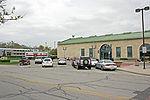
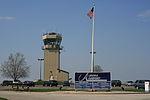
The city is the final stop of the Burlington Northern Santa Fe line of the Metra commuter rail system, allowing rail service into Chicago. The city also has a stop at the Rt. 59 station on the BNSF Line. This station is located on the border with Naperville and each city maintains a parking lot on their respective sides of the tracks. PACE operates local bus service within Aurora six days a week (no service on Sundays) and serves other cities such as Naperville, Geneva, Batavia, Oswego, and St. Charles. Metra trains and PACE buses stop at the Aurora Transportation Center. Greyhound buses used to stop there, but service was discontinued on September 7, 2011. Aurora does not currently have a stop for Amtrak trains, as the old station where they did stop closed in the 1980s. Aurora City Lines, the old city bus lines, was closed in the late 1980s, in favor of regional bus service. Aurora also used to have an extensive streetcar system, operated by the Aurora, Elgin and Fox River Electric Company, that served most neighborhoods. Additionally, Aurora was served by a number of interurban lines. The most prominent of these was the Chicago Aurora and Elgin Railroad which provided service into Chicago. The STAR Line will have a third station at Ferry Rd. north of the BNSF Line.
The Aurora Municipal Airport is a general aviation airport located in Sugar Grove, Illinois, just outside of Aurora. Although the airport is located within Sugar Grove, it is owned and operated by the City of Aurora. The Aurora Airport is designed as a reliever airport for Chicago's O'Hare and Midway Airports, and also handles a lot of international cargo. It is capable of landing Boeing 757 aircraft. In addition, the Federal Aviation Administration's (FAA) Chicago Air Route Traffic Control Center is located on Aurora's west side.
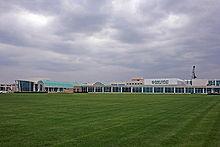
Aurora currently has two hospitals, one on the west side, Provena Mercy Medical Center, and one in Fox Valley, Rush aeCopley Medical Center.
There are other area hospitals, including Edward Hospital in Naperville, Delnor Hospital in Geneva, Central DuPage in Winfield and a Level 1 Trauma center at Good Samaritan in Downers Grove.
Aurora at one point had three hospitals, St. Joseph Hospital, on the west side, St. Charles hospital, east of downtown, and Copley Memorial Hospital, on the east side. St Joseph and St, Charles hospitals have been converted into senior living centers, and the old Copley hospital, which was one of the largest hospitals in the area, sits vacant. The city of Aurora recently demolished the old smokestacks from the hospital, as they were starting to crumble and fall down.
Dreyer Medical Clinic and several other independent clinics and medical groups are spread throughout the city. The area surrounding Provena Mercy has evolved into a diverse healthcare district with services and offices.
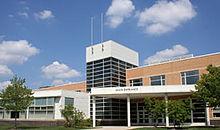
The city is the location of the Illinois Mathematics and Science Academy (IMSA) and Aurora University. According to the census of Aurora's population over the age of twenty-five, 26% hold a bachelor's degree.
Two main school systems have served the Kane County core location of Aurora since the 1860s, one on either side of the Fox River, which physically divides the city. In addition, the far eastern portion of Aurora within DuPage County, has been served by Indian Prairie School District (IPSD) 204, since that district's formation in 1972. All three districts (Aurora Public Schools: West Side (District 129), Aurora Public Schools: East Side (District 131) and IPSD) have their headquarters and administrative offices within the Aurora city limits. As of 2005, there will be no less than forty public schools within Aurora city limits, serving residents of Aurora and neighboring communities.
Due to the sheer size of the city of Aurora, these are not the only three school systems serving residents - some students in the far north end of the city (north of I88 in Kane County) attend Batavia public schools, some on the far southwest side attend Kaneland CUSD 302 schools (headquartered in Maple Park), and some students in the far south end of the city (a small corner of the Kane, Kendall and Will County portions) attend Oswego public schools. Four of the schools in Oswego CUSD 308, Wheatlands Elementary, Homestead Elementary, Wolf's Crossing Elementary, and Bednarcik Junior High, are located within Aurora's city limits.
The Illinois Mathematics and Science Academy (IMSA) is a state-funded residential magnet school for grades 10 to 12. While IMSA operates under public funds (and uses the site originally designated West Aurora High School North Campus), it is managed independently of the other public schools in the city of Aurora. Any Illinois student who meets admission requirements may apply to attend IMSA, tuition free.
Aurora is also home to a few other private schools. Within Aurora, there are three Roman Catholic High Schools, Aurora Central Catholic (Diocese of Rockford), Rosary, and Marmion Academy (Order of St. Benedict), and 7 Catholic elementary schools operated by the Diocese of Rockford. Along with these three schools is Aurora Christian High School and Elementary School. Aurora is also home to Fox Valley Montessori School, one of the first Montessori schools established in Illinois in 1969, which offers a preschool and elementary program.
The above-named districts have forty-six public schools within the city limits of Aurora (seventeen for District #131, thirteen for District #129, eleven for District #204, four for Oswego District #308 and the Illinois Mathematics and Science Academy). Aurora is also home to twenty-two private schools including Rasmussen College, two branches of Waubonsee Community College, and the main campus of Aurora University.
The Aurora Public Library includes the main library, two branches, a support facility and a bookmobile. The current library operations budget is $10 million and the staff numbers 85 full-time and 89 part-time employees.
In addition to the Chicago broadcast stations, the following are based in Aurora:
The Beacon News is Aurora's oldest business, first published in 1846, and is part of the Sun-Times Media Group. The newspaper has two editions: the Aurora edition and the Kendall County edition. The Beacon-News has been recognized repeatedly by the Associated Press, Illinois Press Association, Northern Illinois Newspaper Association and the Chicago Headline Club as one of the best daily newspapers in Illinois.
In 2008, reported major crimes in Aurora were at their lowest level in nearly three decades. The Chief of Police attributed the drop to a number of factors but especially credited the hard work of the city's police officers and the increase in anti-gang priorities. Gang violence had reached a high in the 1990s, with the city averaging nearly 30 murders per year. In 2008, Aurora only had 2 murders. In July 2007, the Aurora Police Department and the FBI conducted "Operation First Degree Burn," a sweep that resulted in the successful arrest of 31 alleged Latin Kings gang members suspected of 22 murders dating back to the mid-1990s. Aurora has also adopted programs such as CeaseFire to reduce gang violence and prevent youths from joining gangs.
Environmentally, Aurora has long dealt with pollution of the Fox River. The river was heavily polluted up until the 1970s by factories that had lined the river for over a century. Cleanup efforts have been successful with the help of state grants and volunteer efforts.
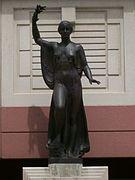
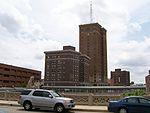
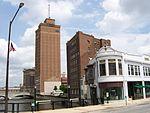
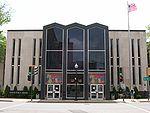
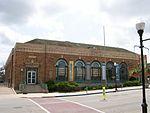
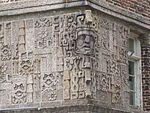
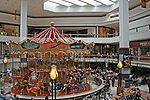
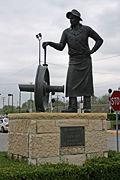

Word Count: 4920






